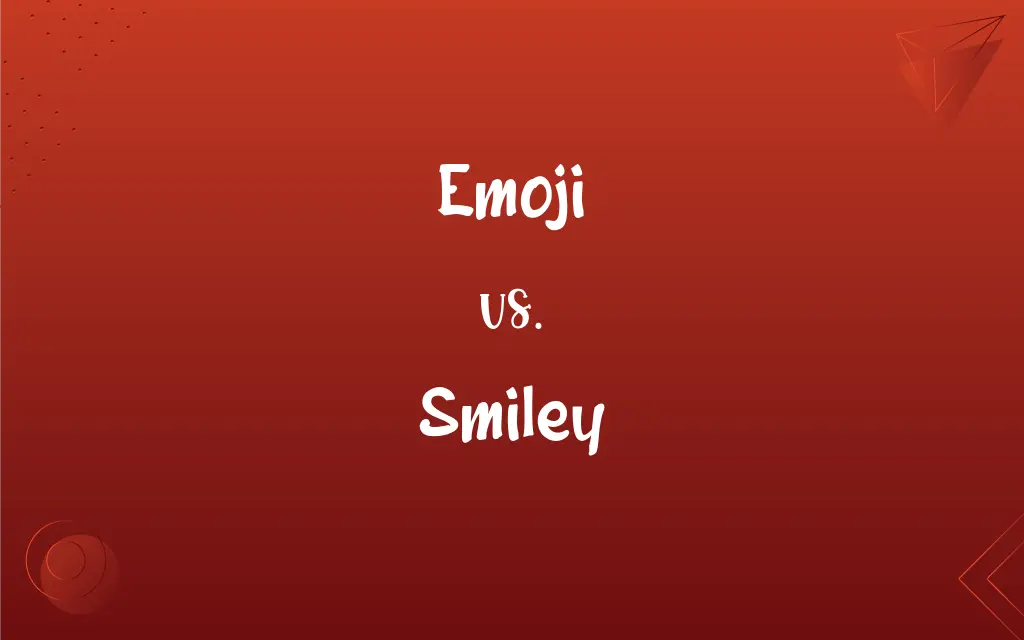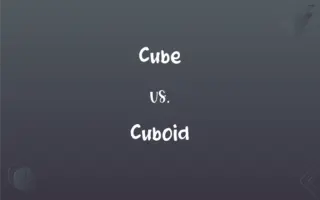Emoji vs. Smiley: What's the Difference?
Edited by Aimie Carlson || By Janet White || Updated on October 6, 2023
Emoji are digital icons representing emotions, objects, and concepts; smileys are specific emojis resembling facial expressions.

Key Differences
Emoji is a word derived from the Japanese terms "e" (picture) and "moji" (character). In contrast, the term ". Smiley" comes from the combination of "smile" and the "y" suffix, denoting a visual representation of a smiling face. While emojis cover a broad spectrum of images, including animals, objects, places, and various symbols, . smileys are limited to representing mainly facial expressions or emotions.
Emoji has been integrated into modern communication to add context, emotion, or nuance to text. On the other hand, . smileys were one of the first graphic representations used in digital communications to convey emotions, primarily in the early days of the internet. Emojis can be of various themes and categories, such as food, animals, weather, activities, and more. In contrast, . smileys mainly denote feelings and moods with their facial expressions.
Emoji is a more encompassing term in the digital age, having a vast array of icons. Many of these icons are officially encoded and recognized worldwide, as they are part of the Unicode standard. . Smiley, being a subset of emoji, can be considered as the pioneering icons before the vast proliferation of emojis. They predominantly represent a face, with variations in expressions to convey different feelings.
Emoji can also represent actions, flags, professions, and a host of other categories. Their purpose is to visually enhance and support textual communication, making it richer and more engaging. Meanwhile, . smileys, due to their limited scope, primarily focus on human emotions. They often have a circular face and discernible features such as eyes, mouth, or sometimes eyebrows to reflect various moods.
The popularity and adoption rate of emoji have been more extensive due to their vast variety and their official encoding. They are now ubiquitous across platforms, apps, and devices. . Smileys, being the precursors to emojis, laid the foundation for the rise of digital icons, offering a visual way to communicate feelings and moods in an era where text dominated online interactions.
ADVERTISEMENT
Comparison Chart
Origin
Derived from Japanese: "e" + "moji"
Coined from "smile" + "y"
Variety
Wide range (emotions, objects, places, etc.)
Primarily facial expressions
Encoding
Part of the Unicode standard
Not necessarily Unicode standardized
Usage
Enhance textual communication
Represent feelings in digital communication
Popularity
Ubiquitous across platforms
More prevalent in early internet days
ADVERTISEMENT
Emoji and Smiley Definitions
Emoji
A digital icon used in electronic communication.
I use the heart emoji to show my affection.
Smiley
An icon primarily representing human emotions through facial features.
The surprised . smiley was perfect for his reaction.
Emoji
A visual element derived from the Japanese terms "e" (picture) and "moji" (character).
The sushi emoji makes me hungry!
Smiley
A specific graphic depicting a smiling face.
I added a . smiley to lighten the mood of my email.
Emoji
A graphical representation of feelings, things, or ideas.
She sent an umbrella emoji to suggest it might rain.
Smiley
A visual representation used to convey emotions in digital communication.
She added a sad . smiley to show her disappointment.
Emoji
A character that adds context and nuance to text messages.
The thumbs up emoji indicates approval.
Smiley
A digital face used in early internet communication to express moods.
I remember when the simple . smiley was the only icon available.
Emoji
A digital tool enhancing expressiveness in modern communication.
He always includes a laughing emoji in his jokes.
Smiley
A precursor to the wider range of emojis, often showing facial expressions.
The winking . smiley can indicate a playful tone.
Emoji
A standardized ideogrammatic icon, as of a face or a heart, used especially in electronic messages or on webpages.
Smiley
An emoticon, especially a smiling facial glyph [ :-) ] used to express delight or to indicate humor or irony.
Emoji
Such icons considered collectively.
Smiley
Having a cheerful and happy disposition; smiling.
Emoji
A digital graphic icon with a unique code point used to represent a concept, object, person, animal or place, originally used in Japanese text messaging but since adopted internationally in other contexts such as social media. Or, by extension, any non-standard emoji-like image inserted inline in text, i.e. an image emoticon.
Smiley
Cheerful and happy; smiling.
Have a smiley demeanor
A very smiley girl
Smiley
(slang) Having one's throat slit from side to side.
Smiley
A simplified representation of a smiling face.
Smiley
(Internet) A sequence of text characters used to represent a happy mood, especially :)]] or :-)]] or other depiction of smiling.
Smiley
(rare) An improvised street weapon consisting of a length of chain with padlocks and other heavy objects affixed to one end.
Smiley
(South Africa) A roasted sheep's head.
Smiley
The type of piercing of the upper frenulum (upper lip).
Smiley
An emoticon of a smiling face
FAQs
How did the term . smiley originate?
The term ". Smiley" is derived from "smile" with the "y" suffix, indicating a visual representation of a smiling face.
Are all smileys emojis?
Yes, smileys are a subset of emojis, specifically representing facial expressions.
What is an emoji?
Emoji are digital icons used in electronic communication to represent emotions, objects, places, and more.
Were . smileys prevalent before emojis?
Yes, . smileys were more prevalent in the early days of internet communication.
Is there a difference in the range of emojis and . smileys?
Yes, emojis cover a broad spectrum, while . smileys primarily represent facial expressions.
Can emojis represent countries or activities?
Yes, there are emojis for flags, sports, professions, and many other categories.
Why are emojis so popular?
Emojis enhance textual communication, making it more expressive and engaging.
Were . smileys the first digital icons for expressing emotion?
Yes, . smileys were among the first graphic representations to convey emotions in digital communications.
Is the term "emoji" specific to the English language?
No, "emoji" is derived from Japanese but is now globally recognized.
Are there cultural differences in interpreting emojis and . smileys?
Yes, some emojis or . smileys might have different meanings or interpretations across cultures.
Are emojis universally recognized?
Most emojis are part of the Unicode standard and are thus recognized across platforms and devices.
Can . smileys denote emotions other than happiness?
Yes, . smileys can represent various emotions through different facial expressions.
How do emojis enhance online communication?
Emojis provide visual context, emotion, and nuance, enriching the textual content.
Are . smileys limited to happy and sad faces?
No, . smileys can depict a range of emotions, from happiness and sadness to surprise and confusion.
Can I create my own . smiley or emoji?
While you can design your own, official emojis are determined by the Unicode Consortium.
Did . smileys evolve into emojis?
. Smileys laid the foundation, but emojis evolved as a broader concept encompassing more than just facial expressions.
How do platforms keep updating with new emojis?
Platforms often update in alignment with the Unicode standard, which periodically releases new emojis.
How do I use an emoji in a sentence?
Emojis can be added before, after, or within text to provide context or emotion.
About Author
Written by
Janet WhiteJanet White has been an esteemed writer and blogger for Difference Wiki. Holding a Master's degree in Science and Medical Journalism from the prestigious Boston University, she has consistently demonstrated her expertise and passion for her field. When she's not immersed in her work, Janet relishes her time exercising, delving into a good book, and cherishing moments with friends and family.
Edited by
Aimie CarlsonAimie Carlson, holding a master's degree in English literature, is a fervent English language enthusiast. She lends her writing talents to Difference Wiki, a prominent website that specializes in comparisons, offering readers insightful analyses that both captivate and inform.































































